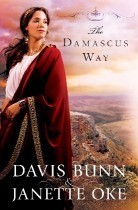Davis Bunn's Blog, page 47
February 16, 2011
The Sadducees and Jesus: First-Century Power Players, Part 8

To help you better understand the historical-cultural context of the Acts of Faith series (The Centurion's Wife, The Hidden Flame, and The Damascus Way), I'd like to introduce you to the primary Judean authorities at the early part of Acts. This is Part 8 of 10.
The Sadducees and Jesus
The Sadducees considered themselves devout Jews, though they had worked out an elaborate theology which permitted them to remain in active alliance with the pagans who ruled the land God had given the Jews. Their thinking went like this: God in his wisdom has separated himself from humans. Jews must remain devout and wait until God reinserts himself into the world.
The Scriptures foretold how this would happen in very precise terms: Elijah would be sent to earth to proclaim the Messiah's arrival. Until this happened, until God acted, the Sadducees were free to make the best of a bad situation.
So Rome is in control? Fine. The Sadducees would make Rome their ally. In return, Rome's governor would keep the Sadducees in control of the Sanhedrin. The Roman army would keep the oppressed Jew, in particular those pesky Pharisees and the troublemaking Zealots in Samaria and Galilee, in line.
The Romans used the Sanhedrin to keep a finger on the Jewish pulse. When the Zealots began making trouble in earnest, when so-called prophets preached about a kingdom other than Rome, the Sadducees on the ruling council told Rome about it. Anything that threatened Roman control also threatened the Sadducees' hold on power. They used one another.
The Romans were utterly ruthless when it came to anything that threatened their power structure. On the other hand, the Romans were also masters at the art of compromise, playing one faction against the other. This is why the Romans insisted upon both Sadducees and Pharisees having places on the ruling council.
Even though the Sadducees were their allies and the Pharisees their foes, even though the Romans made sure the Sadducees held the upper hand on the council and controlled the Temple, the Pharisees played a very useful role: keeping the Sadducees from too much power. So long as both sat upon the Sanhedrin, they fought each other. So long as they were at odds, the council could not unite against the Romans. This tense and fractious balancing act lasted almost two hundred years.
Until that moment an obscure prophet entered the Judean stage and overturned the Roman power base. Alone save for a handful of disciples, armed only with his voice and with hands that reached out with miraculous power, Jesus changed everything.
When the Sadducee-controlled Sanhedrin came to Pilate and demanded the crucifixion of this pesky prophet, Pilate wanted no part of it. Yet he agreed.
Why?
Once this troublesome prophet was gone, Pilate thought, the Sanhedrin and the Sadducees would remain.
And what was more, they would owe him.
Here are links to each of the books in the Acts of Faith Series. I believe it will enhance your understanding of first-century power players to read the novels as we progress through this series.



To make sure you receive every article in this 10-part series, please subscribe to my blog via e-mail or your feed reader by clicking this link: http://feeds.feedburner.com/DavisBunn
Coming next: Back to the Pharisees






February 15, 2011
The Zealots: First-Century Power Players, Part 7

To help you better understand the historical-cultural context of the Acts of Faith series (The Centurion's Wife, The Hidden Flame, and The Damascus Way), I'd like to introduce you to the primary Judean authorities at the early part of Acts. This is Part 7 of 10.
The Zealots
Between World War Two and the founding of Israel in 1948, a group known as the Haganah operated in Israel. Some of these men and women were religious Jews and some were not, but all were united by the goal of a free Jewish state. They in turn were opposed by some religious Jews who protested that Israel should be restored only by the miraculous hand of God and the coming of the Messiah.
The parallels between the Haganah and the Zealots of two thousand years ago are nothing short of astounding.
The Zealots' single-minded determination to overthrow Rome put them totally at odds with the Sanhedrin, the ruling Jewish council. As their popularity grew and their reach extended, they vied with the Pharisees as being the Sadducees' most hated foe.
Since the Maccabeus revolt of three hundred years earlier, numerous groups had been talking rebellion. But the Zealots were different. They were organized. They were disciplined. And their numbers were growing.
Twenty-eight years after the death of our Lord, the Zealots actually managed to defeat three Roman legions and rule all of Israel for six years. Then Valerian and his son Titus, both of whom would go on to become emperors, arrived with three legions from Rome and another six from Africa. After defeating the Zealot armies, they laid siege to Jerusalem.
The Zealots held out for almost two years, slaughtering the Sadducees when they wanted to surrender. In 72 ad the Romans finally broke into the city and burned Jerusalem to the ground, destroying the Temple utterly. The Romans then literally salted the earth so the Jews would never again use Jerusalem as a rallying point, fulfilling Jesus' prophecy that no two stones would remain atop one another.
The Zealots initially were attracted to Jesus, hoping he would prove to be the leader they yearned for. The Scriptures do not tell us their response when Jesus told them this was not his purpose on earth. But we can safely assume they were bitterly disappointed. Even so, we know at least one of them was among our Lord's closest followers. Simon the Zealot was paired with Judas Iscariot when they were sent out on their first evangelism mission.
Here are links to each of the books in the Acts of Faith Series. I believe it will enhance your understanding of first-century power players to read the novels as we progress through this series.



To make sure you receive every article in this 10-part series, please subscribe to my blog via e-mail or your feed reader by clicking this link: http://feeds.feedburner.com/DavisBunn
Coming next: The Sadducees and Jesus






February 14, 2011
The Sanhedrin: First-Century Power Players, Part 6

To help you better understand the historical-cultural context of the Acts of Faith series (The Centurion's Wife, The Hidden Flame, and The Damascus Way), I'd like to introduce you to the primary Judean authorities at the early part of Acts. This is Part 6 of 10.
The Sanhedrin
The Sanhedrin was the Jewish ruling council. While the Romans were the absolute political power over Israel, the Sanhedrin was the governing body over daily Jewish life.
Above the Sanhedrin loomed the Roman power structure—Pontius Pilate as the Roman provincial governor and Herod Antipas, whom the Roman emperor had appointed. But the common Judean individual had no connection to Rome, other than avoiding the soldiers on street duty during the high holy days. The power to affect their lives was held by the Sanhedrin. No secular Jew was permitted to sit upon this ruling council. And the council was dominated by the Sadducees.
Unlike Greece, which had ruled Israel until the Maccabeus revolt some two centuries earlier, Rome did not insert itself into provincial daily life. Greece wanted all its conquered subjects to become thoroughly Greek—clothing, language, competing in their games, worshiping their gods in Greek temples.
Rome did not care what god a conquered nation worshiped, so long as that temple did not incite revolt against Rome. Rome cared about four things—collecting taxes, protecting Roman roads, defending the borders, and ensuring Rome was supplied with plenty of local produce. Other than that, Rome pretty much left the provincial structures in place.
There were several notable exceptions, including one that holds special significance to believers: The Sanhedrin could not condemn a man to death for sedition—this is why the ruling council had to petition Pontius Pilate to crucify our Lord.
Also in Jesus' time, the southeastern borders of the province known as Judea marked the limit of Roman power. South of the Golan hills, rising only thirty miles east of Capernaum, began the vast Parthian empire. Precisely where the Roman province of Syria began and the Parthian kingdom began depended upon who had won the latest battle.
But this was not why Rome was so worried about Judea. So concerned, in fact, that in Jesus' time the emperor Tiberius decreed that Pontius Pilate answer directly to him, an astonishing development almost unknown in Roman history. All other provincial governors answered to the Roman Senate.
The reason for this anxiety is not mentioned directly in any known historical document. But the alarm and the decrees are real, because they are referred to by numerous authorities dating from that time. And from this we can presume the real reason.
Jews were everywhere. Contemporary historians estimate that Jews made up about five percent of the total population of Rome, making them the largest minority in the empire's capital itself.
Not only that, they held positions of influence. Accounts suggest that the majority of these Jews were Hellenized, assimilated into the Roman or Greek cultures, so they were Jews in name only—particularly in the eyes of the Pharisees. But not all of them had left behind either their heritage or their worship of Jehovah.
We do not have any account of a Daniel arising to influence the Roman emperor of the time. But one rather astonishing legend has managed to survive the two thousand years separating us from them.
But first I need to explain one aspect of Roman law. In direct translation from the original Latin, it outlawed the crime of atheism. In its original form, atheism was not a worship of no god. It was worship of a god that defied Roman rule. And other than promoting outright revolt, the worst way it could be displayed was through proselytizing.
As Christianity began to spread across the empire, certain rulers came down very hard on these new believers. The ruling emperor and the provincial governors, if they disliked Christians enough, could sentence them to death by any number of means—scourging, crucifixion, torture, the arena games, and on and on, a tragic litany of martyrdom that began with the stoning of Stephen. This law stayed in place right down to the moment when the Roman emperor Constantine converted to Christianity on his death bed, and with virtually his last breath revoked this foul law.
What is extremely interesting is this fact, which has only recently been uncovered: The law was not originally written against Christians. It was first directed against the Jews.
Whether Jews actually went out and sought converts, even among the Jewish community, is doubtful. Rabbinical sources from this period suggest there was little contact between the devout Jewish community and the Hellenized Jews, both because of religious differences and because of economic barriers. Poor devout Jews had nothing whatsoever to do with rich Jews, who were deeply involved in the Roman culture and did not believe in God. Even devout Jews, aliens living on the fringes of an empire occupying their homeland, would not have attempted to convert Romans to Judaism.
And yet it happened. Thirty-seven years before Jesus carried his cross up the rise to Golgotha, a certain woman in Rome became a secret follower of this Jewish God. Disgusted by the obscene idol worship at many Roman temples, which reflected the wicked culture that dominated the empire, she sought a spiritual path lined by morality and directed toward a God who cared—who cared for her.
The problem was that this woman happened to be the sister of Caesar.
Further, she decided to make her decision public. She had no choice, not after her brother the emperor declared himself a deity and ordered all his subjects to offer temple sacrifices in his honor. Which, as a God fearer, she could not do.
The emperor was furious at his sister's declaration of allegiance to this Jewish God. He responded by banning all Jews from Rome. The women and children were simply expelled. All men between the ages of eighteen and forty, married or single, were given the choice of either joining the Roman army or facing crucifixion. Thirty thousand of these recruits were shipped out all over the empire, most never to be heard from again.
This emperor finally died and was replaced by another who opposed the severity of his predecessor's decision. With the decree revoked, Rome within twenty years again held a significant population of Jews. By the time Jesus began his earthly ministry, many Jews once more held influential positions in Rome.
But also at that time, Tiberius came to power, and he was so fearful of how these Jews might respond to a revolt in Judea that he decreed his newly appointed governor, Pontius Pilate, answer directly to him. As noted earlier, Pilate was the only provincial governor to have this direct access. This was both good and bad. If Pilate succeeded, Tiberius might well lavish him with more power. If he failed, the Roman Senate, which despised him for usurping their power structure, would not have left his toenails intact.
There is no doubt that the Sanhedrin, the ruling council in Jerusalem, was totally aware of their unique position. Recognized by Rome, along with their control over the Judeans, the Sanhedrin used their power to their own benefit. Such as when an obscure prophet from Galilee rose to a position of prominence among the local population and their authority was threatened.
Pilate, who was trapped between a local council that battled him at every step and an emperor who had ordered him to maintain calm in Judea, had no choice but to publicly wash his hands over the fate of the most innocent man who had ever lived.
Here are links to each of the books in the Acts of Faith Series. I believe it will enhance your understanding of first-century power players to read the novels as we progress through this series.



To make sure you receive every article in this 10-part series, please subscribe to my blog via e-mail or your feed reader by clicking this link: http://feeds.feedburner.com/DavisBunn
Coming next: The Zealots






February 11, 2011
The Scribes: First-Century Power Players, Part 5

To help you better understand the historical-cultural context of the Acts of Faith series (The Centurion's Wife, The Hidden Flame, and The Damascus Way), I'd like to introduce you to the primary Judean authorities at the early part of Acts. This is Part 5 of 10.
The Scribes
The first-century scribes are often portrayed as simply copying the text of the Scriptures. But the scribes were also responsible for education. They specialized in the intricacies of the Law, maintaining the exactitude of the holy texts and their interpretations.
Scribes were most often Pharisees but could also be Sadducees. It is widely believed that all the scribes referred to in the Gospels were Pharisees, so we will focus our attention upon this group.
These scribes were obsessed with the end times. They might spend entire lifetimes in endless discussions over the apocalyptic texts, such as the visions of Daniel.
The Pharisees and their scribes were concerned enough about Jesus' early teachings that they went out into the countryside and searched for him. At that point, the Sadducees basically ignored him.
Why?
Because Jesus began talking about the kingdom of heaven, which he claimed was close at hand. They easily dismissed a poor Galilean, and a Nazarene at that, and his talk about heaven.
In contrast the Pharisees lived for this, their scribes in particular. So when Jesus began his teaching on the kingdom, revealing his vision at odds with their own, he came into direct conflict with the scribes.
These Pharisee scribes had a checklist, one developed over generations. They knew precisely how the Messiah was to come and how the end times were going to unfold. To be a Pharisee and a scribe meant that they had memorized these texts, imbedded them into the fabric of their daily life. They had it down cold.
When they heard Jesus say the kingdom of heaven is here—it is now, and when he chided them for becoming lost in minutia and forgetting their responsibilities to the people, they were incensed. From that moment on, they conspired to shut him down.
Here are links to each of the books in the Acts of Faith Series. I believe it will enhance your understanding of first-century power players to read the novels as we progress through this series.



To make sure you receive every article in this 10-part series, please subscribe to my blog via e-mail or your feed reader by clicking this link: http://feeds.feedburner.com/DavisBunn
Coming next: The Sanhedrin






February 10, 2011
Jesus and the Pharisees: First-Century Power Players, Part 4

To help you better understand the historical-cultural context of the Acts of Faith series (The Centurion's Wife, The Hidden Flame, and The Damascus Way), I'd like to introduce you to the primary Judean authorities at the early part of Acts. This is Part 4 of 10.
Jesus and the Pharisees
The Pharisees were by far the closer of these two dominant forces to the lowly, the oppressed, the voiceless, the lost. They were connected to the very people Jesus came to save. They also were vitally interested in the center point of Jesus' teaching—the kingdom of heaven. The issues surrounding the end times were the most important single component of their biblical studies.
And, ironically, it was toward this group that Jesus aimed his fiercest criticisms. He called them whitewashed tombs, swallowers of camels, blind fools, filth, goats, trumpeters, dirty plates, mumblers on street corners, and the like.
What was even worse, he flaunted their rules—healing on the Sabbath, allowing his disciples to pick wheat on a holy day, casting out demons. This, according to the Pharisees, revealed that he was in league with unclean spirits. Worse, this son of a Nazarene carpenter dared call himself a king.
But the deed the Pharisees could never forgive was this: Jesus publicly accused them of getting God's message all wrong. In return they accused Jesus of destroying the Scriptures, though he had stated that not one comma in the Holy Book was ever to be altered. What Jesus was denying them was the power of interpretation, their reason for being.
Here are links to each of the books in the Acts of Faith Series. I believe it will enhance your understanding of first-century power players to read the novels as we progress through this series.



To make sure you receive every article in this 10-part series, please subscribe to my blog via e-mail or your feed reader by clicking this link: http://feeds.feedburner.com/DavisBunn
Coming next: The Scribes






February 9, 2011
The Sadducees: First-Century Power Players, Part 3

To help you better understand the historical-cultural context of the Acts of Faith series (The Centurion's Wife, The Hidden Flame, and The Damascus Way), I'd like to introduce you to the primary Judean authorities at the early part of Acts. This is Part 3 of 10.
The Sadducees
When I began my study of the Pharisees, the word that came repeatedly to mind was conflicted. In Hebrew they were called Tziddukim, which means "the righteous ones." Given their state when we meet them in the Gospels, their title carries a bitter irony.
The title Tziddukim came into existence centuries earlier because their main opponents, the Sadducees, focused exclusively upon the Torah, the five books of Moses also known as the Pentateuch. The Sadducees excluded Talmudic interpretations of the Torah entirely. This spotlight on the words of the Torah rather than its ultimate meaning and application put them in direct and sometimes violent odds with the Pharisees.
Like the Pharisees, the Sadducees saw themselves as strict observers of God's law. But there was a crucial difference between the two groups, an issue so great that they genuinely loathed one another. The motives behind these factions so intensely opposed to one another hinged on two issues: earthly power and spiritual connectedness.
The Sadducees rejected the concept of a hereafter. Individuals lived out their days, either righteously guided or not, and then it was over. At the moment of death, people returned to dust and ashes. And herein lies the crucial element of the Sadducees' religious perspective—they lived by logic, by intellect.
The Sadducees recognized no direct connectedness between man and God. They believed that intimacy with the divine was impossible. God created the world. He gave man commandments by which to live. His chosen people were instructed in how to maintain a moral life. And then God backed away. His work on earth was over. Man was to follow the Law because of the rightness of the action. How could there be anything more, since there was neither heaven nor hell?
This is the point where things become interesting. At the time of Jesus, the Sadducees were in control; they were far more powerful politically and economically than the Pharisees. The writers of that epoch adhered to one group or the other, and the two sects were so at odds it is impossible to gain an unbiased impression.
But most scholars agree that an actual Sadducee was in truth a distinct minority within the Judean population. Most of this sect came from what is called Hellenized Jews. These people had assimilated into the Greek or Roman culture and utterly rejected the commandments and the belief that God had appointed the Jews as his chosen race. They fully embraced the culture and lifestyle of the people with whom they lived—gods, temples, and accompanying sinful ways.
The Sadducees held a sort of compromise position. They were Hellenized, and yet they also considered themselves good religious Jews. Whether they actually believed in God as the Father of the world probably came down to the individual. Some did, others did not. The structure of their belief system made room for both types, within a theology that can only be described as intensely liberal.
Generally, these were also the Jews with money. They were better educated, held the good jobs, traveled, mingled with the Romans. They were connected to the power structure. In today's parlance, the Sadducees were basically the ones who got things done.
The Sadducees dominated the ruling council, the Sanhedrin, and the Temple. In Jesus' time, the high priest, a Sadducee, had to receive his stamp of approval from the Roman governor. And this stamp came only after the would-be high priest delivered two items: a massive bribe along with his personal vow of loyalty to Roman rule. The Pharisees would rather have died than offer either, and many did.
The Pharisees did not disagree with the Sadducees merely over points of religion. They disagreed with them about everything.
Here are links to each of the books in the Acts of Faith Series. I believe it will enhance your understanding of first-century power players to read the novels as we progress through this series.



To make sure you receive every article in this 10-part series, please subscribe to my blog via e-mail or your feed reader by clicking this link: http://feeds.feedburner.com/DavisBunn
Coming next: Jesus and the Pharisees






February 8, 2011
The Pharisees: First-Century Power Players, Part 2

To help you better understand the historical-cultural context of the Acts of Faith series (The Centurion's Wife, The Hidden Flame, and The Damascus Way), I'd like to introduce you to the primary Judean authorities at the early part of Acts. This is Part 2 of 10.
The Pharisees
The movement that identified themselves as the Pharisees arose out of their abhorrence of the attitudes and habits of the increasingly worldly culture. Jesus' appearance on earth came at a time when God had effectively washed his hands of his chosen people. The prophets repeatedly had called for the Jews to return to Jehovah and leave their wicked ways. The Pharisees saw themselves as the only group that truly echoed that call.
Most Judeans ridiculed the Pharisees and their devout habits. They responded to this scorn by distancing themselves from society. Everything they did, including their dress, was a magnification of the Law as they interpreted it.
Over time the Pharisees had become vehemently attached to innumerable rules and regulations in an attempt to protect and preserve the law as given to Moses, dictating whether or not an individual could lay claim to the term righteous. They dressed a certain way, maintained certain attitudes toward the politics of their time, were meticulous in their eating habits, and held to a rigid structure of prayer. The Pharisaic scribes considered themselves the lone guardians of God's law.
Here are links to each of the books in the Acts of Faith Series. I believe it will enhance your understanding of first-century power players to read the novels as we progress through this series.



To make sure you receive every article in this 10-part series, please subscribe to my blog via e-mail or your feed reader by clicking this link: http://feeds.feedburner.com/DavisBunn
Coming next: The Sadducees






February 7, 2011
The First-Century Power Players

The disciples of Jesus were shaped by the religious culture and the political climate of their day. How they dealt with the Messiah's death and what happened upon the Master's reappearance and ascension are both touched by their culture.
The Acts of Faith series (The Centurion's Wife, The Hidden Flame, and The Damascus Way), take place in AD 33, immediately following the crucifixion of Jesus. To help you better understand the historical-cultural context of the books (and of the biblical and historical characters Janette Oke and I fictionalized), I'd like to introduce you to the primary Judean authorities at the early part of Acts.
You'll learn why the power structure responded to Jesus and his followers as it did.
The years after Jesus' return to heaven saw only an escalation of antagonism from the religious leaders, and along with the resulting persecution came expansion of the believers' understanding of the new covenant, which now included the Gentiles.
What does this mean for us in the here and now?
To my mind, the similarities and parallels to today's world are nothing short of amazing.
During this series of blog posts, which will run weekdays for the next two weeks, I'll introduce you to the major first-century power players, including:
The Pharisees
The Sadducees
Jesus and the Pharisees
The Scribes
The Sanhedrin
The Zealots
The Sadducees and Jesus
Back to the Pharisees
What This Means for Us
Here are links to each of the books in the Acts of Faith Series. I believe it will enhance your understanding of first-century power players to read the novels as we progress through this series.
This is going to be an exciting series; I can't wait to share my findings with you. To make sure you receive every article, please subscribe to my blog via e-mail or your feed reader by clicking this link: http://feeds.feedburner.com/DavisBunn
We'll begin by discussing The Pharisees in tomorrow's post.






February 4, 2011
Praying for Unemployed Writers

Wallyce had a lovely comment for Lourie, the woman who has recently lost her job. I thought it would be nice to share this:
I so enjoyed reading how you created and lived out your "Anna and the Blue Rose" character. Having been unemployed and knowing well what it is to (virtually always) live on limited funds, I know what it is to be in a season like you are experiencing.
I lifted you in prayer today… that your current season would end in a blessing of a job that stimulated you and your obvious creative imagination as well as providing the financial resources needed. Here's to a new season of growth and adventure. God's the One who will lead you from one to the next… it's hard, but hold tight to His Hand… He's gotcha.






February 2, 2011
Reader Couldn't Put Down 'The Damascus Way'

 Gary writes:
Gary writes:
Finished The Damascus Way just before leaving for a week in Branson, MO. I couldn't put it down, as is true with other great authors I read.
But the thing about your writing goes further than not being able to put it down. I feel, in every book of yours I have read, that you are behind me pushing through the book. You are such a powerful writer.
My Response:
Thanks so much for the gift of your response. I do feel this is the best book Janette and I have done. Janette goes back and forth between this and The Meeting Place. In any case, I just want to say how much your words have meant to us both.
Reader reviews of other books in the Acts of Faith series:
The Centurion's Wife
The Hidden Flame
**Note: Would you like to review one (or all) of the books in the Acts of Faith series — on your own blog and/or on my blog? If so, please notify my blog manager, Laura Christianson at Blogging Bistro, and she'll explain how to submit your review.









